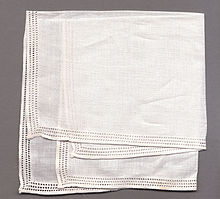A handkerchief /ˈhæŋkərtʃɪf/, also called a handkercher or hanky, is a form of a kerchief, usually made of thin fabric that can be carried in the pocket or purse. It was invented for personal hygiene purposes such as wiping one's hands or face, or blowing one's nose.

A handkerchief is also sometimes used as a purely decorative accessory in a suit pocket.
Modern usage
changeThe material of a handkerchief can be symbolic of the social-economic class of the user. It is not only because some materials are more expensive, but because some materials are more absorbent and useful for those who use a handkerchief for more than style. Handkerchiefs can be made of cotton, cotton-synthetic blend, synthetic fabric, silk, or linen.
Origin
changeBefore people used the word handkerchief, the word kerchief alone was common. This term came from two French words: couvrir, which means “to cover,” and chef, which means “head.”
In the time of ancient Greece and Rome, handkerchiefs were often used the way they are today. But in the Middle Ages, kerchiefs were usually used to cover the head.
-
A man pictured (1901) in a three-piece suit with pocket handkerchief showing
-
Suits with pocket handkerchief
-
Men in suits with pocket handkerchief
-
A woman using a handkerchief for personal hygiene
-
A Mouchoir, a type of handkerchief
Other websites
changeMedia related to Handkerchiefs at Wikimedia Commons